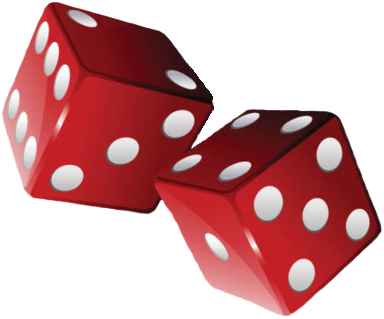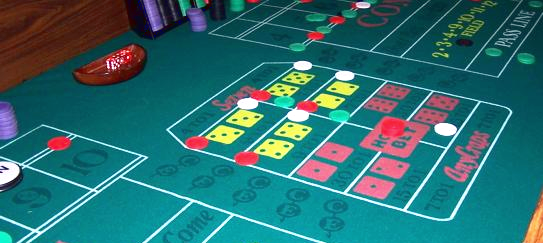
Craps Bets · How to place a bet on craps · Craps payouts
In review #
The Pass Line, Don’t Pass, Come, Don’t Come, and Free Odds or True Odds bets on the Craps layout should be understood at this point. But before moving forward to more complicated bets, a review of what was explained, discussed, and learned should be gone through.
- A shooter will be shooting a Come Out roll.
OR - Trying to roll the Point again before a seven comes up.
These are the two most quintessential steps that drive “The Game Of Craps.” And they will go on, and on, and on, and on; never ending, never changing.
On a Come Out roll after a Point has been rolled…
If a shooter has rolled a few numbers before rolling the point for a Pass Line winner, the Come and Don’t Come bets and their respective Free Odds or True Odds are still sitting on the numbers. Several things can happen to those bets depending on what the player wants to happen.
- The Come and Don’t Come bets are always ON and cannot be otherwise. A bet is a bet, cannot take it back.
- If a 7 is rolled, the Come bets lose
- If a number that a bet is on is rolled, the Come bet wins.
- The Come bet Free Odds or True Odds bets are always OFF but can be called ON.
- If they are OFF and a 7 is rolled, the Come bet Free Odds or True Odds bets are given back the the player; again, the Come bet itself loses.
- If they are OFF and a number that a bet is on is rolled, the Come bet wins but the Free Odds or True Odds bets are given back the the player.
- If they are ON and a 7 is rolled, the Come bet and its Free Odds or True Odds bets lose.
- If they are ON and a number that a bet is on is rolled, the Come bet and the Free Odds or True Odds bets win.
So whether a players wants them ON or OFF is up to the risk the player wants to take.
Side Bets #
In addition to the basic bets, and whilst the game plays on, the game allows the making of Side Bets — also called Proposition, prop, or exotic — and are arranged all over the layout and can be for a single roll of the dice or multi-Roll.
SEMANTICS [TO] or [FOR]: It is important to mention and understand.
Before making a side bet or proposition bet look at the pay-out info. It may read “FOR 1” or “TO 1.”
- If it reads TO 1, the pay-out is X for that one-dollar bet plus that one-dollar is given back for a total of X + 1, unless it is left to ride.
- If it reads FOR 1, this is where it can get tricky especially at the low end Casinos and their interpretation. The pay-out is Y for that one-dollar bet and the house takes the one-dollar. total of Y.
Basically the pay-out is the same: X + 1 = Y; 4 to 1 is the same as 5 for 1.
The thing to keep an eye out for is when it reads less than the standard pay-outs , such as 4 for 1 — DO NOT PLAY AT THESE PLACES!
Multi Roll Bets #
The Pass Line, Don’t Pass, Come, Don’t Come, and Free Odds or true Odds bets are all multi-roll bets — they may require more than one roll of the dice to determine the outcome.
In addition to these multi-roll bets, there are a few more — some not as smart to bet as others.
Place, Buy, and Lay #
Place To Win #
The Place or Place To Win bet is a that can be placed on any of the Point numbers 4, 5, 6, 8, 9, or 10 at anytime, but is usually made after a point number is already established. The player is betting that the placed number will roll before a 7.
| Number bet on | Payout Odds | True Odds | Example | House Edge |
|---|---|---|---|---|
| 4 or 10 | 9 to 5 | 2 to 1 | a $5 bet is paid $9 | ≈ 6.67% |
| 5 or 9 | 7 to 5 | 3 to 2 | a $5 bet is paid $7 | ≈ 4% |
| 6 or 8 | 7 to 6 | 6 to 5 | a $6 bet is paid $7 | ≈ 1.515% |
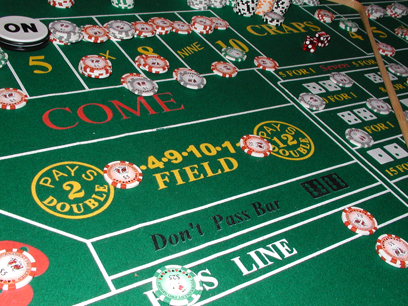 Place Bets:
Place Bets:
- Can be put up or taken down at any time.
- They are automatically OFF — or not working — on the come out roll; they can be called ON or OFF at anytime if desired.
- The lowest house percentage Place bets are on the 6 and 8. The others are not so great but can be improved by making buy bet instead.
Place To Lose #
The Place to lose bet is basically the opposite of the Place bet. The player is betting that a 7 will roll before the number. This bet can be made at any time, but is usually made after a point number is already established.
| Number bet on | Payout Odds | True Odds | Example | House Edge |
|---|---|---|---|---|
| 4 or 10 | 1 to 2 | 2 to 1 | a $2 bet is paid $1 | ≈ 3.03% |
| 5 or 9 | 2 to 3 | 3 to 2 | a $3 bet is paid $2 | ≈ 2.50% |
| 6 or 8 | 5 to 6 | 6 to 5 | a $6 bet is paid $5 | ≈ 1.818% |
 Buy #
Buy #
The Buy is similar as the Place bet except that there is a 5% vigorish, or vig, up-front in exchange for receiving the True odds.
The vig is figured on the amount wagered. If a twenty-dollar Buy bet is made on the 4, the player puts the bet in the Come area and tells the dealer “Buy the 4.” The Dealer will move the bet to the number 4 point box and place a BUY button on top of it. When it does roll the dealer will pay off at forty-dollars and ask for one-dollar (5% of twenty-dollars) is the vig for the house. The players tosses a dollar chip onto the tabel. The result is that the bet will win forty-dollars (2 to 1) instead of thirty-six-dollars (9 to 5). The process repeats when the bet wins again.
NOTE: Some casinos want the the vig at the time of purchase, and you do not get it back if it does not win.
The timing for paying the vig varies among casinos. Generally, competition determines whether a casino makes you pay after a winning bet or at the time you make the bet. If several casinos are near each other, they probably take the vig after a win, whereas if the casino is the only gambling hall in a 100-mile radius, then it might make you pay the vig at the time you make the bet. Where there is competition, the a smart casino knows if it tries to screw the players by making them pay the vig up front, they will not have, any players playing their tables, but at the casino next door.
Suppose you make a ten-dollar Buy bet on the 10. Paying the vig “up front” means you must pay the one-dollar vig at the time you make the bet. So, instead of dropping ten-dollars on the table and telling the dealer to Buy the 10, you must drop eleven-dollars (i.e., two five-dollar chips and a one-dollar chip). The dealer puts your two five-dollar chips in the Buy box and puts the one-dollar chip in the casino’s stack. In this case, the casino gets one-dollar from you before the bet even begins. If the shooter rolls a 10, the dealer gives you twenty-dollars. In this example, the dealer does not ask you to drop one-dollar for the vig because you already paid it “up front.”
Paying the vig “after a win” is better for the player because you pay the vig only if you win. If the shooter rolls a 7-out, all you lose is your ten-dollar bet. By making you pay the vig after a win, the casino decreases its house advantage slightly to attract players to play at their table instead of the competition’s.
Some casinos have minimums for their Buy bets. You may not be able to buy the 4 or 10 for less than twenty-dollars or twenty-five-dollars. The casino might not allow a ten-dollar Buy bet. As a test, you can put ten-dollars in the Come box and say, “Buy the four, please.” The dealer might say, “The Buy bet has to be at least twenty dollars,” If they do not allow it. You can either place it or buy it for twenty-dollars. The reason they do not allow it is a mute point since they are just dealers and not the own of the casino, so asking and expecting a good explanation is a waste of time.
The Buy bet on the 5 or 9 can be good, bad, or a wash compared to the Place bet, depending on the bet amount and when you have to pay the vig. Suppose you are at a casino that allows you to Buy the 5 for ten-dollars. The true odds for the 5 and 9 are 3:2. Your winning ten-dollar Buy bet wins fifteen-dollars, but you have to pay a one-dollar vig (i.e., the vig is 5% of ten-dollars = 50 cents, which is rounded up to one-dollar), so your net win is fourteen-dollars. The Place odds on the 5 and 9 are 7:5, so your winning Place bet wins fourteen-dollars. In this example, the payout for the Buy and Place bets are equal, so the bets are considered a wash, and not worth making the bet.
| Number bet on | Payout Odds | True Odds | Example | House Edge |
|---|---|---|---|---|
| 4 or 10 | 2 to 1 | 2 to 1 | a five-dollar bet is paid ten-dollars - 5% vig | ≈ 4.76% |
| 5 or 9 | 3 to 2 | 3 to 2 | a ten-dollars bet is paid fifteen-dollars - 5% vig | ≈ 4.76% |
| 6 or 8 | 6 to 5 | 6 to 5 | a six-dollar bet is paid five-dollars - 5% vig | ≈ 4.76% |
Buy Bets:
- Can be put up or taken down at any time.
- They are automatically OFF — or not working — on the come out roll; they can be called ON or OFF at anytime if desired.
- The lowest house percentage Buy bets are on the 4 and 10. The others are not so great.
Lay bets #
The Lay Bet is basically the opposite of the Place Bet. The player is betting that a seven will roll before the laid number. This bet can be made at any time, but is usually made after a point number is already established.
| Number bet on | Payout Odds | True Odds | Example | House Edge |
|---|---|---|---|---|
| 4 or 10 | 1 to 2 | 2 to 1 | a five-dollar bet is paid ten-dollars - 5% vig | ≈ 2.439% |
| 5 or 9 | 2 to 3 | 3 to 2 | an eight-dollar bet is paid fifteen-dollars - 5% vig | ≈ 3.226% |
| 6 or 8 | 5 to 6 | 6 to 5 | an eleven-dollar bet is paid five-dollars - 5% vig | ≈ 4% |
The Hard Ways #
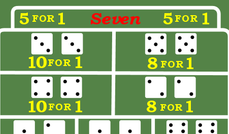 The Hard Way bets are located just underneath the Seven bet in the Proposition area, which is in the center of the layout on the table — since these are considered to be a Proposition bet.
The Hard Way bets are located just underneath the Seven bet in the Proposition area, which is in the center of the layout on the table — since these are considered to be a Proposition bet.
A Hard Way in craps, is any roll of the dice where both die show the same number. A 4 and a 4 is a hard 8. Any other combination that totals eight is referred to as the Easy Way. This is because, for all even numbers, there is only one combination on the dice that will roll it the Hard Way. Even the 2 and 12 are the hard way — the only way, which makes them the super hard way. Yes a player can bet it, but they are single roll bets.
The hard way bets will win if the number comes up the hard way, and lose if it comes up the easy way or a 7.
| Hard Way | Payout Odds | True Odds | Example | House Edge |
|---|---|---|---|---|
| 4 and 10 | 7 to 1 | 8 to 1 | a one-dollar bet is paid seven-dollars | ≈ 11.11% |
| 6 and 8 | 9 to 1 | 10 to 1 | a one-dollar bet is paid nine-dollars | ≈ 9.091% |
The Hard Way Bets:
- Can be put up or taken down at any time.
- They are automatically ON — or working — on the come out rolland cannot be called OFF.
STICKMAN [hard 4]: “Double deuce” • “Deuce deuce on the loose” • “Pay the Man/Woman with the tu tu” • “Double snake eyes”
STICKMAN [easy 4]: “Little Joe” • “Thirty One”
STICKMAN [hard 6]: “Pair-o-treys” • “Thirty Three” • “Six six double sticks”
STICKMAN [easy 6]: “The national average” • “Sixie from Dixie”
STICKMAN [hard 8]: “Square pair, like mom and dad” • “A dot in each corner”
STICKMAN [easy 8]: “Eighter from Decatur”
STICKMAN [hard 10]: “Puppy paws” • “pair-a-roses” • “Pair of sunflowers” • “Fifty-five to stay alive” • “Big Dick” • “Pay the Man/Woman with the big dick”
STICKMAN [easy 10]: “Sixty-four, wanting more.” • “Sixie from Dixie”
Big 6 and Big 8 #
 The Big 6 and Big 8 bets are located close to the players for easy betting and there is a reason for that — These are by far the worst bets to make, and the casino wants to make it convenient for the player to make them.
The Big 6 and Big 8 bets are located close to the players for easy betting and there is a reason for that — These are by far the worst bets to make, and the casino wants to make it convenient for the player to make them.
When a players places a Big 6 or Big 8 bet or both, the player is betting that the bet the number bet will come up before a 7 — no different than any other bet on the table except the pay off. It is an even money win.
Why go through all that trouble to win even money when the Place bet pay off is 7 for a 6? Sure it is betting more than a player may want, but if a player cannot make a proper bet with the proper amount needed, STEP AWAY FROM THE TABLE AND GO HOME!!
Single Roll bets #
Single Roll bets are determined by the out come of the next roll of the dice — it will either win or lose — which is why they have the highest pay-out and the lowest odds or chances of winning.
Field #
![]() The Field bet encompasses the numbers 2, 3, 4, 9, 10, 11, and 12 and is an even money bet except on the 2, which pays [double: 2 to 1], and the 12, which pays [triple: 3 - 1].
The Field bet encompasses the numbers 2, 3, 4, 9, 10, 11, and 12 and is an even money bet except on the 2, which pays [double: 2 to 1], and the 12, which pays [triple: 3 - 1].
The house edge on the field is 2.77%.
Taking another look at the Dice Combinations Table or calculate the math behind craps.
Dice Combination Table #
Number
2
3
4
5
6
7
8
9
10
11
12
Combination
1-1
1-2, 2-1
1-3, 3-1, 2-2
1-4, 4-1, 2-3, 3-2
1-5, 5-1, 2-4, 4-2, 3-3
1-6, 6-1, 2-5, 5-2, 3-4, 4-3
2-6, 6-2, 3-5, 5-3, 4-4
3-6, 6-3, 4-5, 5-4
4-6, 6-4, 5-5
5-6, 6-5
6-6
Ways To Roll
One
Two
Three
Four
Five
Six
Five
Four
Three
Two
One
There are 16 possible ways to make the numbers in the field.
There are 20 possible ways to make the numbers NOT in the field.
There are better and worse bets.
Proposition Bets #
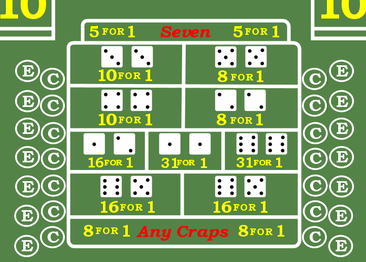 In casino games, the house offers proposition bets which are often not favored by experienced gamblers, as the house edge on them far exceeds the edge on the normal game.
In casino games, the house offers proposition bets which are often not favored by experienced gamblers, as the house edge on them far exceeds the edge on the normal game.
Craps also has these proposition bets that offer higher payouts but again, at a higher house advantage.
A neat feature about these proposition bets is they can be made at anytime during the game — anytime except maybe while the dice are in mid roll.
The proposition bets are placed in the middle of the craps table with the craps stickman handling the bets, because he would proposition you to make that bet.
STICKMAN: “Get your eleven bets 15 to 1! C and E! Any Craps! Right here!”
Combination Bets #
Casino's offer a way to bet multiple bets at once.
 Any Craps - C #
Any Craps - C #
Located at the very bottom of the Proposition area, and along the sides, it with the C inside a circle, the Any Craps bet — also called Craps — is betting that the next roll, and only the next roll, will be either a 2, 3, or 12.
It pays seven-dollars for every one-dollar wagered. Some tables may read 8 for 1; it still pays seven-dollars whether they give back the one-dollar or not. (see semantics)
C and E #
Located to each side of the Proposition area with the C and E inside their own circle, the C and E bet is another way to bet Any Craps and Eleven on the next roll, and only the next roll
Some toss two-dollars and say “C and E” Thus putting a one-dollar on each of the craps and eleven bets. Why? Remember these are Proposition bets.
It pays seven-dollars for every one-dollar wagered. Some tables may read 8 for 1; it still pays seven-dollars whether they give back the one-dollar or not. (see semantics)
Horn #
Located just above the Any Craps bet, the Horn bet encompasses the 2, 3, 12, and 11 with a minimum bet of four-dollars — one-dollar for each number on the next roll, and only the next roll. If the table layout does not have the horn bet, a player can still make one most often.
The Horn bet is basically betting the numbers individually, but the convenience of the Horn bet is not having to say “A dollar on the two. A dollar on the three. A dollar on the twelve. A dollar on the eleven.” Just toss the money and say “Horn” Some players toss a five-dollar chip and say, “Horn high Eleven.” So there will be one-dollar on each of the 2, 3, and 12, and $2 on the eleven. One can easily say “Horn high Three.”
There is no Horn pay-out like the Any Craps bet; each number has its own pay-out; (see 2. 3, 11, or 12).
Keep in mind that 3 out of the 4 bets will lose. If a 2 is rolled, and a $4 Horn bet was made, three-dollars is taken away, but the one-dollar on the 2 will win.
Single Number Bets #
One can bet the numbers individually and at their discretion.
Seven #
STICKMAN: “Seven out, line away” • “Five two, you are all through” • “Big Red” • “Six ace, end of the race” • “Front line winner, back line skinner” • “Up pops the devil” • “Seven is a bruiser, the front line is a loser” • “Grab the money”
The Seven, or sometimes called Any Seven — there are some layouts that allow a player to bet a particular way the dice will come up as 7 — is located at the top of the Proposition area; the Seven bet is betting that the next roll, and only the next roll, will be a 7 — Any Seven.
It pays four-dollars for every one-dollar wagered. Some tables may read 5 for 1; it still pays four-dollars whether they give back the one-dollar or not. (see semantics)
2 #
STICKMAN: “Craps” • “Deuce” • “Sanke Eyes” • “Two aces” • “Rats eyes” • “Two craps two” • “dimples” • “Take the come double the field”
The 2 is located inside the Horn area; the 2 bet is betting that the next roll, and only the next roll, will be a 2.
It pays thirty-dollars for every one-dollar wagered. Some tables may read 31 for 1; it still pays thirty-dollars whether they give back the one-dollar or not. (see semantics)
3 #
STICKMAN: “Craps” • “Ace Deuce” • “Australian Eleven” • “Winner on the dark side” • “Three craps three” • “Three craps, ace caught a deuce, no use” • “Take the come pay the field”
The 3 is located inside the Horn area; the 3 bet is betting that the next roll, and only the next roll, will be a 3.
It pays fifteen-dollars for every one-dollar wagered. Some tables may read 16 for 1; it still pays fifteen-dollars whether they give back the one-dollar or not. (see semantics)
11 #
STICKMAN: “Yo Leven” • “Yo” • “Sixty-Five stayin’ alive” • “Pass Go and collect”
The 11 is located inside the Horn area; the 11 bet is betting that the next roll, and only the next roll, will be a 11.
It pays fifteen-dollars for every one-dollar wagered. Some tables may read 16 for 1; it still pays fifteen-dollars whether they give back the one-dollar or not. (see semantics)
12 #
STICKMAN: “Craps” • “Boxcars” • “Atomic craps” • “A triple in the field” • “Midnight” • “Crapus Maximus” • “Push the don’t” • “All the spots we got” • “Take the come triple the field”
The 12 is located inside the Horn area; the 12 bet is betting that the next roll, and only the next roll, will be a 12.
It pays thirty-dollars for every one-dollar wagered. Some tables may read 31 for 1; it still pays thirty-dollars whether they give back the one-dollar or not. (see semantics)
Unusual Single Roll bets #
There are some unknown bets that at some Casinos they may still know them, but these are often gone with the true old-time gambler
The World #
The World or Whirl, bet is similar to the Horn, but it includes the Seven in addition to the 2, 3, 11, and 12 bets betting that the next roll, and only the next roll, will be either a 2, 3, 7, 11, or 12. Each number has its own pay-out; (see 2. 3, 7, 11, or 12).
The minimum bet is five-dollars for the The World as it is basically putting a one-dollar bet on each of those numbers. Again, much easier saying “Five-dollars on the World.” Instead of calling each number out.
Keep in mind that 4 out of the 5 bets will lose. If a 2 is rolled, and a five-dollar World bet was made, four-dollars is taken away, but the one-dollar on the 2 will win.
Hop Bets #
A Hop bet is betting that the next roll, and only the next roll, will result in one particular combination of the dice — this is a rare bet and most Casino’s do not offer this.
If a Casino is found that offers the Hop bet, making the Hop bet is as easy as saying, while tossing chips to the Stickman, “Hopping hard way four!” Or “Hopping seven!” Any number or combination can be called a Hop bet, such as, “Hopping four!”
The pay-out for the Hop bets are:
- Even numbers are paid thirty-dollars for every one-dollar wagered.
- Odd number hop bets are paid fifteen-dollars for every one-dollar wagered.
The House Edge #
Depending on the bets you make, the house edge in craps can vary from less than 1% to more than 16%. No other casino game offers such a great opportunity to make both wise and foolish bets. Here is a quick comparison of the edge for each of the bets in craps.
BET: HOUSE HEDGE
Don’t Pass line or Don’t come (single odds): 0.68%
Pass line or come (single odds): 0.85%
Don’t Pass line or Don’t Come (no odds): 1.36%
Place bets: 1.52% to 6.67%
Buy bets: 1.67% to 4.76%
Lay bets: 1.27% to 4.00%
Big 6 and 8: 9.09%
Hard ways: 9.09% to 11.11%
The field: 2.77% to 5.56%
Seven: 16.67%
Any craps: 11.11%
2 or 12: 13.89%
3 or 11: 11.11%
The horn: 12.50%
The world: 13.33%
Craps vs. Other Casino Games
The pass line at craps is one of the best bets in the entire casino. Combined with a single odds bet, which is available almost universally, the house edge on the pass line is less than 1%. This is better than every game except blackjack. With a 10× odds bet, available at many major casinos, the house edge drops to a razor-thin 0.18%, and thinner at a 100x table.
GAME: HOUSE HEDGE
Blackjack: 0.50%
Baccarat (banker): 1.06%
Craps (pass line with single odds): 0.85%
Craps (pass line with 10× odds): 0.18%
Craps (pass line with 100× odds): 0.1%
Keno: 25%
Roulette (double zero): 5.26%
Slots: 3% or more%
